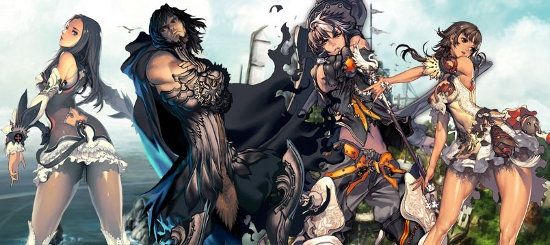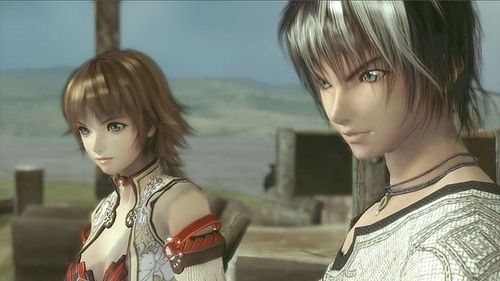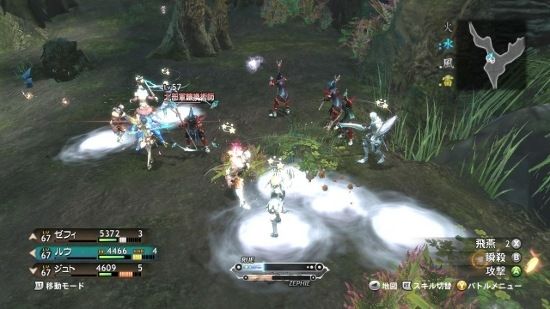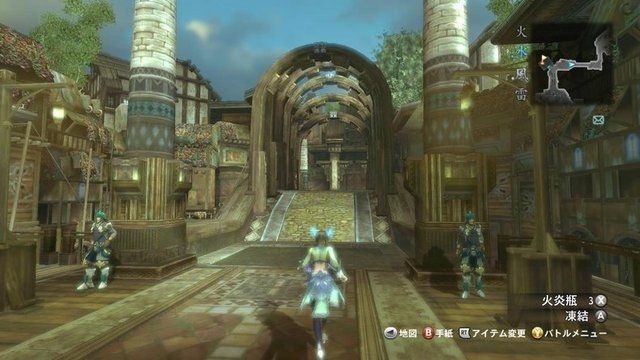Magna Carta 2 is the indirect sequel to the 2005 PS2 title Magna Carta: Tears of Blood. Some good news, though - you don't have to have played the even more obscure earlier titles to understand what's going on here. Magna Carta 2 is based around new characters and attempts to grab your attention with a new story. In fact, the story takes place in the Kingdom of Lanzheim, where there's somewhat of a civil war going on between the Northern forces and the Southern forces. This civil war started when the horribly-named minister Schuenzeit killed the queen and attempted a hostile takeover of the throne. You begin the game on the seemingly peaceful Highwind Island (the name in and of itself invokes memories most JRPG fans cherish). Our hero, Juto, has mysteriously - yet unsurprisingly - lost his memory and now resides in a small village, doing menial tasks and being bossed around by a busty, smack-talking girl named Melissa.
Of course, this idyllic life of his can't last forever - the Northern forces end up attacking because of something in a nearby cave called a Sentinel, and Juto gets mixed up in it all, falling into the company of the Southern army's Counter-Sentinel Unit, headed up by Princess Rzephillda (Zephie for short). This group eventually becomes very familiar to you as the members of this unit are the playable characters throughout the game. The game recalls the trials and tribulations of Juto as he seeks to uncover his real identity. Sure, there are twists and turns (most are predictable, some aren't), but for the most part the story is your standard RPG fare with your typical character archetypes. There's nothing new to see here folks, so if you're interested in something unconventional and fresh, you might have to wait for Final Fantasy XIII.
The visuals are nice, and I really appreciate the art direction in a few of the game's areas - especially your main base of operations throughout the first part of the adventure, Abazet. The wooden (and possibly tile, it's hard to tell) walkways, the narrow streets, the children playing, the ambient sounds of chatter, birds and people going about their daily lives. It really adds to the feel of the game, the richness of your experience in this particular world. The graphics, in general, aren't outstanding, but they're not bad, either. The various different areas of Lanzheim are colorful, teeming with little nuances that only the most observant gamer may pick up.
The character designs are amazing and are based off the work of Korean manga artist Hyung-tae Kim. The in-game character models don't really do his work justice, but the animations and overall design are very pleasing nonetheless. It's a shame the majority of the dialog in the game is given to the player in fairly static screens with the characters who are speaking to/about each other in view, with a few animations based on what the mood of the chat is. Important plot points are covered in true cut scenes, but for most of the dialog you're going to be staring at two large character portraits, which can get rather boring sometimes.
The music and voice acting, while it gets the job done, could have used more work. In a few instances, the voice acting is tolerable (toward the end of the game), in most, however, it's hard to listen to. Juto's overly melodramatic voice bothers me every time a hear it. Did the actor take lessons from William Shatner or something? Celestine, a member of the Mare people, is highly annoying and I just want to shoot her in the eye to shut her up most of the time. There's also an obscene number of gasps from the characters during the dialog sequences, I don't quite get the point. It's like every couple lines the characters are surprised by something the other one said, and many times it's a line of dialog that reveals nothing new or is common knowledge to the characters. What gives?
One thing relating to voice acting though – for a Japanese game, all the actual cut scenes that you see, the characters' lips are matched to the English words. It would be nice if more Japanese titles did that, because it really is one thing that makes those scenes “pop”, at least for me. Kudos to the developers for that!
Where this game really shines, however, is the general game play and battle system. If you enjoyed the battle system in Final Fantasy XII, you'll likely enjoy this one, as well, because the two have a lot in common. There are no battle screens, all the fighting takes place on the field. I'm not a fan of manually "turning on" battle mode, but I can let that slide because the battle system overall is great. In many pseudo-action battle systems (Star Ocean: The Last Hope, Tales of Vesperia, etc.) everyone eventually falls to the lure of button-mashing to get yourself through fights. In Magna Carta 2 that won't fly. In fact, the game penalizes you for button-mashing. As your character attacks and performs actions in battle, they lose stamina (signified by an increasing bar in the middle of the screen, which is a bit odd for decreasing stamina, but whatever). You get maybe six to eight consecutive normal attacks before your stamina is maxed and, once that happens, you go into an "Overdrive" mode, where your attacks become stronger, especially your fancy abilities. After that, you get placed in "Overheat" mode, where you can't do squat. Part of the challenge is not allowing your character to get to that point...unless you want them to.
There are times when you want to push them to the limit and flip them into "Overdrive" (and, from there, into "Overheat"), because, even though it's a penalty for button-mashing, it is the catalyst that begins chain attacks. When one person performs a special attack and, ultimately, goes into "Overheat" mode, you can quickly and easily use the D-Pad to switch to another party member and immediately a chain is initiated, in which that character can perform special attacks with more damage, then follow the mode progression into “Overheat”. This can be followed by the third party member. Here you have the chance to create a "Chain Break", which increases damage output and resets the stamina of your other party members so you can do this all over again. How's that for laying the smack down on some over-sized, mutated boss-like character?
It really provides a lot of strategy and thought to how you use your abilities, when you use them, when to go "Overheat" yourself, when to start a chain, etc. However, taking my comparison to FFXII a bit further, Magna Carta 2's battle system is not as fluid and your AI party members are not as responsive to your needs. This is unfortunate. I died more than once at the hands of a boss because whoever had their AI action set to "Prioritize Healing" sure as hell wasn't doing so. The healers - Zephie and Celestine - tend to sit in the back and pew-pew enemies with their weapon, ignoring the fact that everyone else is low on HP. Occasionally they'll toss out a gigantic heal, then go back to their pew-pew-ing. That was quite disappointing. I'd rather not have to worry overly so about other party members' health - that's the point of having the computer-controlled characters act intelligently, is it not? Because of that, I often had to take up controlling healers for boss fights.
Around the mid-point of the game, you learn how to use dual attacks, which make use of two of your characters at a time. They're powerful attacks but come with large Kan costs. Kan is the magical energy that powers your physical attacks and sorcery. It's generated as you attack, but is used slightly differently by both types of combatants.
There's also quite a few other things that bother me that are (sometimes loosely) related to battle and field actions. I already mentioned you have to manually change between "Battle Mode" and "Normal Mode" in the field. This is compounded by the fact that you have to be in "Normal Mode" when you wish to perform a field-only action, such as kicking a shell, setting a barricade on fire or harvesting a plant for a quest. Those actions, in my opinion, should be available in "Battle Mode", as well. Your movement speed also slows way down when in combat, and that's highly aggravating at times, especially when enemies tend to slowly back away from you almost faster than you can approach them to attack.
Along the way through the story, there are a plethora of side-quests to hit up, all of which give nice experience and item rewards. Most of these are well designed and fit right in with the Counter-Sentinel Unit's current mission and the game's story progression. You can skip these, but it's not advisable, because with them, there is no grinding at all in the entire game. That optional quest experience really comes in handy!
On the technical side of things, there are a few issues. There isn't much slow-down, but there are uncapitalized or misspelled words in the text and texture popping issues all over the place. It isn't so much that it dampened my enjoyment of the game, however.
All in all, if you love JRPGs, you're most likely going to enjoy this game. I certainly did – it's a nice breath of fresh air from all the other titles coming out this fall. The game does have its fair share of problems – depending on your preferences, some may not be problems at all. The average gamer, however, may not take too kindly to some of the game play decisions that were made and there are a few technical issues present. It's an action-packed drama that does a decent job at character interaction and development in the story, while doing an excellent job of giving fans of action battle systems what they want.
[Note: Some screen shots are from the Japanese version, because I couldn't for the life of me find any English ones.]
- Title: Magna Carta 2
- Developer: Softmax
- Publisher: Namco Bandai Games America
- MSRP: $59.99
- Release Date: 10/13/2009
- Review Copy Info: A copy of this title was purchased by DualShockers Inc. for reviewing purposes.





